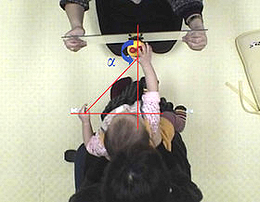Research Abstract
乳児期初期における行為予測と運動能力の発達的対応
乳児はどのようにして他者の行為の目標を理解するのだろうか。行為の理解は、観察された行為が、観察者自身のその行為の運動表象にマッピングされるというメカニズムから生じると考えられている。
Developmental correspondence between action prediction and motor ability in early infancy
2011年6月7日 Nature Communications 2 : 341 doi: 10.1038/ncomms1342

乳児はどのようにして他者の行為の目標を理解するのだろうか。行為の理解は、観察された行為が、観察者自身のその行為の運動表象にマッピングされるというメカニズムから生じると考えられている。しかし、乳児期初期においてこうしたマッチング過程の直接的な証拠を見いだすことは難しい。本論文では、4ヶ月齢から10ヶ月齢の乳児と成人において、注視と関心を引く対象への把持反応とを比較することにより、行為予測と運動能力の間の発達的対応を明らかにする。他者の行為の目標を乳児が予測できるようになるのは、乳児自身がその行為を行えるようになる時期と同期していることが示された。さらに、行為予測能力とそれと同じ行為を行う運動能力の間には対応関係が見られた。我々の知見は、他者の行為目標を予測できるようになるには、その行為に対応する運動能力が必要であることを示しており、これはミラーニューロンシステムによるダイレクトマッチング過程の個体発生的証拠となるものである。
- 京都大学大学院文学研究科
How do infants understand the goals of others’ actions? It has been proposed that action-understanding results from a mechanism whereby an observed action is mapped onto the observer’s own motor representation of that action. However, direct evidence of the matching process in early infancy is difficult to find. Here we show the developmental correspondence between action prediction and motor ability by comparing gazing and grasping responses to interesting objects in 4- to 10-month-old infants and adults. The onset of infants’ ability to predict the goal of others’ action was found to be synchronized with the onset of their own ability to perform that action. Moreover, there was correspondence relationship between action-prediction ability and motor ability of same action. Our findings indicate that the ability to predict others’ action goals requires a corresponding motor ability, providing ontogenetic evidence for a direct matching process by a mirror neuron system.

